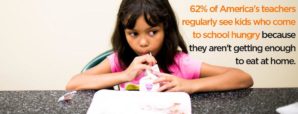
On June 15, 2015 Senator Sherrod Brown of Ohio requested permission to address the United States Senate regarding measures to continue the school lunch program through the summer months:
“Mr. President, for most children around the country the school year has ended and the summer has begun. Some 700,000 children in Ohio, my home State, during the school year receive free or reduced-price school lunches on an average day–some 700,000 children. Those children might not have access to a nutritious meal when school cafeterias close for the summer.
Summer break should not mean a break from good nutrition. That is where the Summer Food Service Program steps in. The U.S. Department of Agriculture works with State departments of education to ensure that every child has sufficient, adequate, nutritious food to keep growing and learning after the final school bell rings. This year in Ohio there will be 1,500 Summer Food Service Program sites across the State.
Last year these sites served almost 4 million meals. Last week, I spoke with Winnie Brewer, who runs these sites in Marion County, OH, in a city about the size of Mansfield, near where I grew up.
According to Winnie, more than one in four kids in her county is food insecure. She talked about one of their newest volunteers, who came to her in tears after watching a 6-year-old boy clean the shelves in an SFSP site–a feeding site–and then start digging through the trash. He was just that hungry. That is why the work Winnie does and her volunteers do is so important.
Right now, too many families don’t know about this critical program. Too many families miss out on receiving its assistance once school lets out. Winnie reports that just 1 in 10 children who receive breakfast or lunch during the school year comes to summer feeding sites. That means that in my State almost 700,000 children on any given school day will be getting a free or reduced-price breakfast or lunch–700,000. But during the summer months, only about 70,000 of those children get these meals or snacks. We need to do all we can to raise public awareness of these programs so that families know that the end of the school year does not mean an end to food services for their children.
In Marion, the city I mentioned where Winnie runs her program, she anticipates she will triple the number of meals she serves this year compared to 5 years ago. That is because she and other community partners have committed to making this program a success. At approved schools, in churches, in summer camps, in synagogues, and in community centers, pools, and recreation centers, volunteers and organizers are ensuring that children have the healthy food they need to succeed.
Those sites often offer more than just healthy meals. They provide summer enrichment activities for kids. We know that low-income children whose parents typically have less education, in the months from school closing in late May or early June until school returns in late August or early September, tend to fall back on their education. In districts such as that where the parents have less education, less ability or know-how to read to the children, to take them on field trips that might make their minds more active, we know those children start every fall having to catch up just to get back to where they were in the spring.
That is one of the beauties of the summer feeding program. So you are not just giving these children nutritious meals, but you are also giving these children library activities and sports activities and other kinds of organized activities at churches, at community centers, at schools, and at libraries that can matter. The sites in Marion County partner with the YMCA to offer exercise. They run a literacy program that provides free books to kids at feeding sites. Getting a new book can turn a child on and get that child more excited about reading.
Earlier this month, I was in Youngstown–a city in northeast Ohio–to get the word out about the summer food and feeding program. I met with Mark Samuel, who operates a site at the West Side Community Center and a couple dozen other sites in Mahoning Valley. I also met with Retha Austin, who has children and grandchildren in the program, and now she is working a few hours a week as a paid worker to help get this program up and running.
Families need to know about these sites and the dedicated folks like Mark, Winnie, and Retha who run them. Summer break shouldn’t mean a break from good nutrition.
I yield the floor.”
Source: Congressional Record
See video: US Children Going Hungry In School Holidays https://www.youtube.com/watch?v=yCgKb6tqYCg
See related story: School lunch worker fired for feeding hungry children https://www.youtube.com/watch?v=6VO3-HPe5yY

